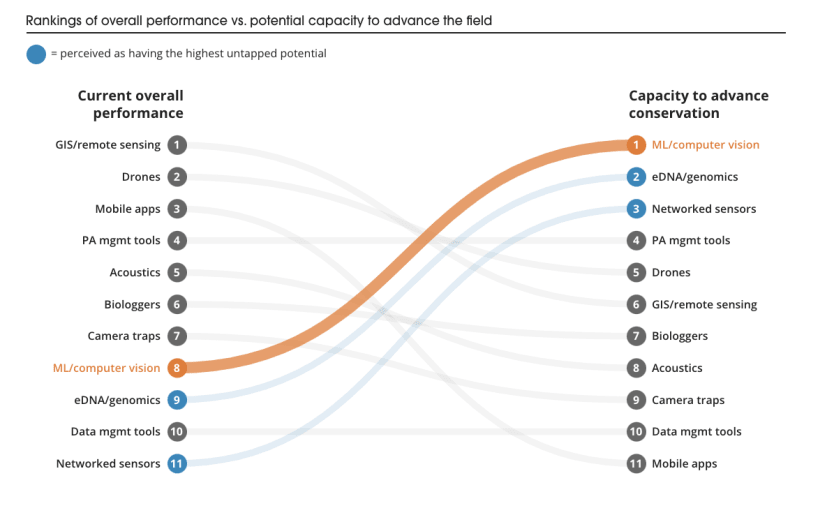
The needs of the conservation technology community are as varied as the work of its members. In every corner of the globe, in every environment, and with every species, someone out there is working with tech tools to meet the constantly growing challenges of conservation: wildlife crime, climate impacts, and the ongoing extinction crisis.
And yet, even as technology’s use becomes more common in the conservation field, understanding how technology can meet those needs and be applied most effectively, where improvements are still needed, and where it will lead us to next is as complicated — and critical — as ever.
Allowing the conservation technology community to guide and inform this field’s path is the surest way to ensure we’re heading in the right direction. Who can better understand the strengths and weaknesses of technologies such as camera traps, machine learning data analysis tools, drones, bioacoustics recorders, and tracking gear better than the people who have already done the hard work of putting these tools into practice?
When those who use conservation technology are given the space to share their honest experiences — both positive and negative — it benefits conservationists and technologists alike. While conservationists can learn from each other’s experiences, so can technologists who build the very tools we use, many of whom have never been into a rainforest or savannah to see how their tools function in unpredictable real-world settings.
This feedback loop between conservationists and technologists ultimately results in a more informed and skilled user base and a stronger selection of more effective tools designed with conservation users in mind. And affordable, useful tools that fit conservationists’ specific needs mean a bigger market of conservationists for the tech sector to explore.

As the leading conservation technology community platform uniting tech users and makers from around the world, WILDLABS is uniquely positioned to understand and address this community’s challenges. WILDLABS’ State of Conservation Technology research is the first formal effort to understand the big picture of this field. In gathering data from conservation tech users and makers from around the world — and in uniting experts in targeted focus groups to discuss the future of these tools — we aim to bring our community’s collective voice to the forefront of the conservation technology sphere.
In this report, we synthesize findings on current technology performance and needed improvements; barriers preventing these tools from reaching maximum impact, and innovations with the power to change the field as we know it.
Our data shows that evolving tools such as machine learning, environmental DNA, and networked sensors rank as the conservation technologies with the highest potentials for future impact. However, our data also shows that common challenges within the field, such as limited funding, inadequate capacity building, and steep learning curves may limit users from meeting that potential if not addressed openly and collaboratively.
Our research has a huge role to play in the aforementioned feedback loop. The report will also be able to guide the development of future programs by WILDLABS that aim to meet the immediate needs of the conservation community and break down barriers by providing resources and more direct connections to tech experts.
According to our 2020 State of Conservation Technology survey that formed the basis for our report, 44% of respondents rated technical barriers — factors such as steep learning curves and non-user-friendly tools for nonexperts — as a “major” or “critical” constraint. Along with difficulties accessing the skills, training, and resources needed to use complex tools effectively, other factors such as high cost can also make tools inaccessible.
Understanding how all of these factors prevent conservationists from making the best use of available technology, or even innovating new solutions that meet their individual needs, can allow the tech sector to improve their tools’ ease of use based on the user base’s experiences. Further, it allows platforms such as WILDLABS to help conservationists learn the right skills, access the right resources, and connect with the right experts.
[The] feedback loop between conservationists and technologists ultimately results in a more informed and skilled user base and a stronger selection of more effective tools designed with conservation users in mind.
—Tools such as machine learning are rapidly changing the game in conservation technology, and their potential for innovation and impact is enormous. But even the most cutting-edge tool cannot reach that potential if it remains inaccessible to many of the people who can use it to the greatest effect. Would-be innovators continually face the challenge of navigating the inevitable barriers to entry, particularly as promising new technologies emerge and evolve.
By recognizing where accessibility issues and barriers exist within the community, platforms like WILDLABS can move the field forward by uniting the conservation and technology sectors to make collaborative change happen. Within our platform, tech users and makers alike will find programs that have been designed based on the priorities and challenges identified in our research.
For example, the Tech Tutors program helps beginners learn the necessary skills to engage with tools such as machine learning with more confidence, while virtual programs Fellowships and Office Hours connect conservationists directly to leaders in the machine learning space, letting tech mentors work with conservationists on impactful projects in the field. And through our research, other leaders in conservation tech will be able to follow WILDLABS’ lead and identify where their own strengths can fill critical gaps in the community’s needs.
Our research zooms out on the community at large, capturing snapshots of the big picture of our field at this moment in time. And the further we zoom out, the more we can see that we are all facing conservation’s biggest challenges together.
We hope that leaders in the tech sector will fully embrace their potential roles in conservation by creating tools with conservationists’ needs, uses, and budgets in mind and by recognizing that innovation is born when conservationists have the tools and resources needed to boldly push the boundaries of possibility. The tech industry has the expertise and resources to advance this field by leaps and bounds; likewise, conservationists still have so much more to offer to the world in terms of impact, if only given the skills, effective tools, and support needed to drive them forward.
Lend your voice to the next phase of our State of Conservation Technology research, by joining our 2021 Annual Survey and exploring our full report.








